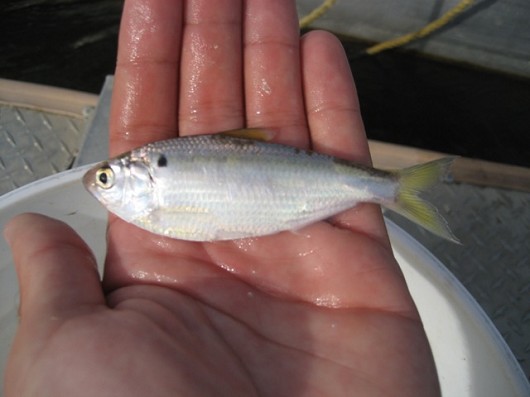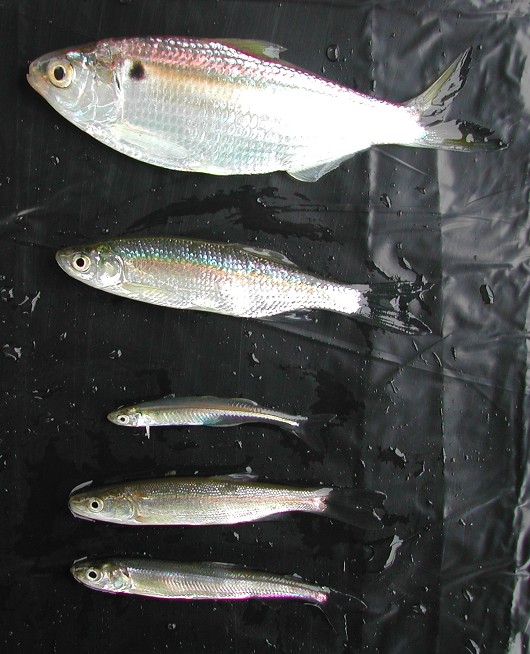Threadfin Shad
-
Scientific NameDorosoma petenense
-
NativeNon-Native
-
Identification
 Threadfin shad, captured in rotary screw trap on the Sacramento River at Knight's Landing on 11/23/2008. Photo by Nicholas Miguel, California Department of Fish and Game.
Threadfin shad, captured in rotary screw trap on the Sacramento River at Knight's Landing on 11/23/2008. Photo by Nicholas Miguel, California Department of Fish and Game. Threadfin shad, shown beside a golden shiner, Mississippi (inland) silverside, Sacramento pikeminnow, and wakasagi. Photo by Robert Vincik, California Department of Fish and Game.
Threadfin shad, shown beside a golden shiner, Mississippi (inland) silverside, Sacramento pikeminnow, and wakasagi. Photo by Robert Vincik, California Department of Fish and Game.- Flattened body with a sawtooth belly
- Belly has 15-18 scutes before the pelvic fins and 8-12 behind them
- Deciduous scales
- Oblique, toothless mouth with an upper jaw longer than the lower
- Usually silver in color often with a blue or black hue at the rear
- A single black spot behind the operculum
- Long, thread like ray at the end of the dorsal fin creating a sickle shape
- 17-27 anal fin rays
- 11-17 dorsal fin rays
- 40-48 scales on the lateral line
-
Life History
Threadfin shad can be found in the open waters of sluggish backwaters, large ponds, and reservoirs where they stay close to the inlets of small streams or along the surfaces of dams. They are dependent on light for foraging and will generally stay high in the water column, rarely dropping deeper than 18 m. They are warm water fish that prefer summer temperatures between 22°C and 24°C and will die if the water drops below 6°C. They are very tolerant of salinity and can even live in salt water although it seems to lead to problems with reproduction. They are most often found in schools organized by size with smaller groups tending to be deeper in the water column, especially at night. It is not uncommon to see these schools very close to the surface as they are chased by fish below and by birds from above. Threadfin shad feed exclusively on plankton but have two methods of catching it, resulting in a broad diet of the available invertebrates. Small zooplankton, phytoplankton, and detritus are filtered through their gill rakers while large zooplankton, especially copepods, are chased down and caught as individual prey. During the day the two methods are mostly balanced but hunting becomes more difficult in low light when the shads ability to see their prey is diminished making filtration the dominant feeding method at night.
Threadfin shad can spawn by the end of their first summer but will usually wait until their second summer to mate. This occurs between April and August and peaks in June or July when temperatures are greater than 20°C although spawning between 14°C and 18°C has been seen. At dawn threadfin shad will gather near a submerged or floating object and will begin charging at it, turning away at the last instant. At this point of turning, eggs or sperm are released and thrown so that they stick to the object or fertilize eggs that are already stuck. Females will release 900-21,000 eggs in a season depending on their size. These eggs will hatch 3-6 days later into planktonic larvae that stay near the surface during the day and fall deeper into the water column at night. They will mature into juveniles when they are 2 cm in length, approximately 2-3 weeks later depending on the water temperature. In optimal conditions they will grow 1-3 cm per month for the first summer but usually reach only 4-6 cm by end of their first year. Few live to be older than 2 years or grow to over 10 cm long. The largest threadfin shad found in California was a 22 cm long individual from the Salton Sea where the salt water decreases reproduction, and thus competition, allowing each individual a larger amount of prey than they would find in a freshwater lake of the same size.
-
Links to Other ResearchN / A
-
WatershedN / A
Please note, watersheds are at the USGS 8-digit Hydrologic Unit Code (HUC) scale, so they often include a lot of sub-watersheds. If a species occurs in any sub-watershed within the HUC, the species appears within the HUC. Link to an EPA page that shows HUCs.

